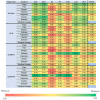A Comparison of Machine Learning Algorithms and Feature Sets for Automatic Vocal Emotion Recognition in Speech
- PMID: 36236658
- PMCID: PMC9571288
- DOI: 10.3390/s22197561
A Comparison of Machine Learning Algorithms and Feature Sets for Automatic Vocal Emotion Recognition in Speech
Abstract
Vocal emotion recognition (VER) in natural speech, often referred to as speech emotion recognition (SER), remains challenging for both humans and computers. Applied fields including clinical diagnosis and intervention, social interaction research or Human Computer Interaction (HCI) increasingly benefit from efficient VER algorithms. Several feature sets were used with machine-learning (ML) algorithms for discrete emotion classification. However, there is no consensus for which low-level-descriptors and classifiers are optimal. Therefore, we aimed to compare the performance of machine-learning algorithms with several different feature sets. Concretely, seven ML algorithms were compared on the Berlin Database of Emotional Speech: Multilayer Perceptron Neural Network (MLP), J48 Decision Tree (DT), Support Vector Machine with Sequential Minimal Optimization (SMO), Random Forest (RF), k-Nearest Neighbor (KNN), Simple Logistic Regression (LOG) and Multinomial Logistic Regression (MLR) with 10-fold cross validation using four openSMILE feature sets (i.e., IS-09, emobase, GeMAPS and eGeMAPS). Results indicated that SMO, MLP and LOG show better performance (reaching to 87.85%, 84.00% and 83.74% accuracies, respectively) compared to RF, DT, MLR and KNN (with minimum 73.46%, 53.08%, 70.65% and 58.69% accuracies, respectively). Overall, the emobase feature set performed best. We discuss the implications of these findings for applications in diagnosis, intervention or HCI.
Keywords: emotional speech database; feature set; machine learning; speech; vocal emotion recognition.
Conflict of interest statement
The authors declare no conflict of interest.
Figures




References
-
- Schuller B.W. Speech emotion recognition: Two decades in a nutshell, benchmarks, and ongoing trends. Commun. ACM. 2018;61:90–99. doi: 10.1145/3129340. - DOI
-
- Cummins N., Scherer S., Krajewski J., Schnieder S., Epps J., Quatieri T.F. A review of depression and suicide risk assessment using speech analysis. Speech Commun. 2015;71:10–49. doi: 10.1016/j.specom.2015.03.004. - DOI
-
- Dong Y.Z., Yang X.Y. A hierarchical depression detection model based on vocal and emotional cues. Neurocomputing. 2021;441:279–290. doi: 10.1016/j.neucom.2021.02.019. - DOI
MeSH terms
Grants and funding
LinkOut - more resources
Full Text Sources
Research Materials
Miscellaneous

